Four Things You Need to Know about Compressed Air Dew Point Sampling
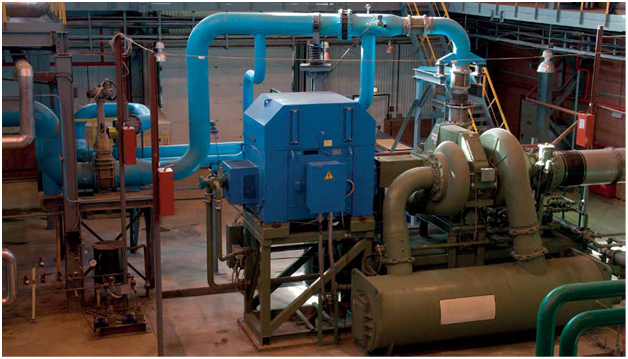
Sampling is needed when direct measurement of the air is undesirable or is simply not feasible.
This may be due to a high process temperature, the need to protect the sensor from water spikes, the added convenience of installing and removing the instrument from a pressurized process without shutting down the line, or wanting to make the measurement in a more convenient location. To get a representative sample of the process gas and avoid potential sources of error caused by incorrect sampling practices, the following aspects should be considered.
1. Changing the pressure of the gas changes the dew point
It is important to keep in mind that changing the gas pressure changes the dew point temperature of the gas. If the sensor is at a different pressure than the process itself, an error of several tens of degrees dew point may be apparent. Generally the measurement should be made at the actual system pressure in order to avoid pressure drops in the sampling system. Exceptions can sometimes be made when standards require reporting the dew point at ambient pressure thus excluding the effect of pressure fluctuations.
2. To avoid condensation the dew point must be below the ambient temperature in the sampling line
When the need for sampling is due to a high process gas temperature prohibiting direct measurement, it is important to ensure that the dew point level of the process is lower than the ambient temperature to which the sample gas is cooled in the sampling line. This prevents water vapor in the sample from reaching saturation causing liquid water to form in the sample line.
In cases where the dew point is higher than ambient temperature, either a direct measurement or a heated sampling line is required.
3. A leak-tight sampling system construction is essential
Due to the very low level of humidity typically found in compressed air and gas systems, dew point measurements are highly sensitive to even the smallest leaks in the system. Consequently the importance of having a leak-tight sampling system is critical. All connections should be tight and sealed correctly. For tapered threads like NPT, use of Teflon tape is recommended. For straight thread connections such as G 1/2″, the sealing washer provided with the instrument should be installed between the probe and the sampling cell.
Careful consideration should always be given to the sampling system’s material of construction since water vapor diffusion through the pipe or tubing walls can occur. The piping should preferably be made of metal, e.g. stainless steel with a good surface finish. Hygroscopic material such as rubber hose and plastics is undesirable and should be avoided. PTFE or Teflon is one exception that is a rather vapor tight plastic and can be used down to a dew point level of about – 40 °C (-40 °F).
Sample tubing should be as short in length as possible and “dead ends” should be avoided. Also minimizing the number of connections helps in avoiding leaks. If possible, prepare the sampling system for the measurement by purging it with the dry process gas sufficiently to ensure a faster stabilization and response time.
4. Sampling in still air should be avoided, however low air flow is okay
Stagnant air can be a problem for a few reasons:
1. A representative sample of the process air may not be obtained.
2. Response time may be dramatically impaired.
3. The risk of ambient air leaking or diffusing through sampling materials increases.
4. Back diffusion of ambient water vapor through the outlet port of the sample cell can occur.
Using a dew point sensor that is not dependent on flow rate is strongly recommended. Although higher flow rates generally improve the sensor response time, flows of 1-2 l/min (0.035-0.7 ft3/min) are typically enough for high-quality sensors.
Overview of Vaisala Sample Cells
DMT242SC Sample Cell – basic model
- A basic sample cell consisting of just the main sampling body.
- The inlet and outlet are female threaded sample connectors (inlet G3/8″, outlet G1/4″ ISO)
- Suitable for users requiring only a sampling cell for a probe and doing further assembly themselves (piping into inlet and outlet, valves and possible flow meter)

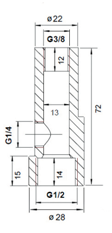
DMT242SC2 Sample Cell – a model with Swagelok® connectors for 1/4″ tubing
- Similar to DMT242SC, but with more simple connections
- The sampling cell includes welded Swagelok® connectors at both the inlet and outlet that fit directly to 1/4″ tubing
- To fit 6 mm tubing to the connectors, an adapter such as Swagelok® Reducer SS-6M0-R-4 (not supplied by Vaisala) can be used
- Suitable choice in e.g. plastics drying systems, where the measurement is made by tapping off the dryer system and bringing a small air stream to the sensor. The Swagelok® connectors of DMT242SC2 easily connect to a cooling coil or tubing providing the essential function of cooling the dry air to ambient temperature before it reaches the sensor.
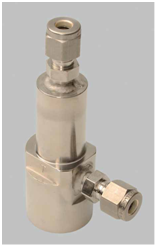
DSC74 Sample Cell with quick connector, leak screw and thread adapters
- Designed specifically for compressed air systems
- Contains an adjustable leak screw that maintains the compressed air system pressure at the cell (the leak screw is opened and closed with a screwdriver, and should be turned 1/2 turn which approximes a 1 l/min flow rate.)
- Comes with a quick connector that fits industry standard compressed air line connectors (allows for easy installation and detachment of the dew point transmitter without having to shut down the process – alternative ways to connect are through the two different thread adapters – G3/8″ to G1/2″ and G3/8″ to G1/4″ ISO – that are supplied with each DSC74 unit)

DSC74B Sample Cell – a two-pressure model for gas pressure and atmospheric pressure furnished with inlet/ outlet valve and inlet/outlet connection for gas tubing
- A two pressure sampling cell allowing for measurements at both system and atmospheric pressures
- Limits the flow rate with a fixed leak screw (the flow is optimized for pressures 3….10 bar and the fixed leak screw eliminates the risk of opening the leak screw fully by accident and this way emptying a gas vessel)
- The maximum flow can be increased, if needed, by removing the leak screw and adjusting the flow manually with the valve
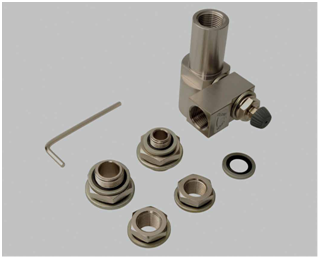
DMCOIL – Stainless steel (AISI316L) coil for sampling cells (DMT242SC, DMT242SC2, DSC74, DSC74B/C)
DMCOIL operation
- Works as cooling coil in gas inlet in high temperature process to cool sample gas temperature down.
- Also acts as venting coil in gas outlet to prevent ambient humidity to disturb low dew point measurement in applications where gas pressure is reduced to ambient pressure prior the sampling cell.
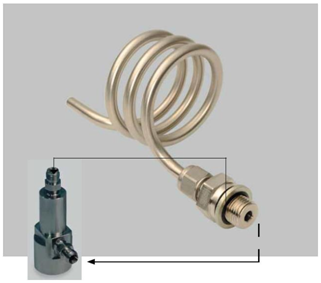
Source by: Vaisala
